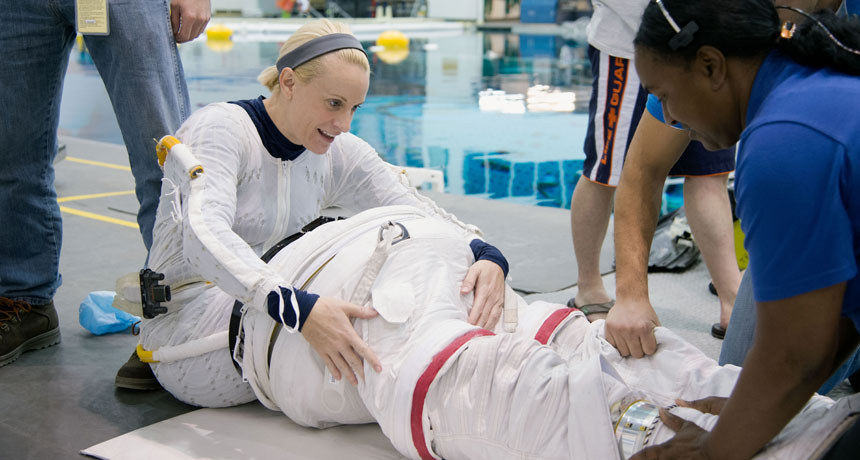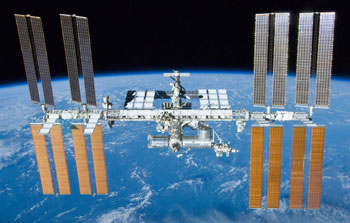Biologist Kate Rubins is headed to space
After leaving the research lab to become an astronaut, she’s now headed for the space station

Molecular biologist and astronaut Kate Rubins puts on a spacesuit at a NASA test lab in Houston, Texas. Astronauts train underwater there to simulate the experience of moving in the weightless environment of space.
James Blair/NASA/Flickr (CC BY-NC 2.0)
On June 24, molecular biologist Kate Rubins will be strapped into a spacecraft in Kazakhstan. Within a few hours she’ll blast off from this central Asian country (directly south of Russia and west of Mongolia). That moment will end seven years of preparing — and 30 years of hoping. She’ll finally be on her way to the International Space Station.
As a child, Rubins plastered her Napa, Calif., bedroom with pictures of stars and galaxies and the space shuttle. She’d proudly tell anyone of her plan to be an astronaut. A week at Space Camp in Huntsville, Ala., in seventh grade cemented that goal. But by high school, she figured that astronaut wasn’t “a realistic job.”

Since then, she’s learned to fly a NASA jet, speak Russian (so she can talk with Russian crewmates), conduct a spacewalk and operate the space station’s robotic arm. She even learned how to fix the space station’s toilet.
Joining NASA meant leaving behind her job running a 14-person lab. But Rubins realized she’d be gaining the rare opportunity to work with dozens of scientists in fields as different as cell biology and astrophysics. On the space station, she’ll be “their hands, eyes and ears.”
Both experimenter and subject

Rubins will spend about five months in orbit. While on the International Space Station, or ISS, she’ll conduct about 100 experiments. She will, for instance, study how heart cells behave when gravity doesn’t get in the way. And she’ll test a miniaturized DNA sequencer — about half the size of a smartphone. Such technology will be important to future missions that might, for instance, look for signs of life on Mars.
In fact, much of the research Rubins will do is helping lay the groundwork for taking people deeper into space. When kids who are middle schoolers today “grow up and are ready to be scientists or engineers, these are the kinds of missions that they’ll have the opportunity to be involved in,” she notes.
Rubins also will be a subject of research on bone growth, while she’s in space.
On Earth, gravity helps keep bone tissue healthy. Putting weight on bones sends a signal to certain cells to keep building new bone. In space, lack of gravity causes astronauts to quickly lose bone. So astronauts work out using specialized exercise equipment that uses vacuums to provide resistance for bones and muscles. Pushing against that resistance “tells bone, ‘Hey, you’re still being used,’” Rubins notes.
Researchers know the exercise program works to keep bones strong. But they don’t know exactly how it affects the bones’ internal structure. So doctors will image Rubins’ bones with a CT scanner before and after her mission. They’ll be looking for any changes to a portion of her hip bone.
WRING IT OUT See astronaut Chris Hadfield do a quick experiment on the International Space Station to illustrate the odd way that water moves under zero gravity. VideoFromSpace |
Rubins is also eager to study how liquid acts in space. In 2013, Canadian astronaut Chris Hadfield created an Internet sensation. In a video from space, he demonstrated that wringing out a wet washcloth caused water to form a bubble that enveloped the cloth and his hands. (Two teenage girls, Canadian 10th-graders, had suggested the experiment.) “It’s incredibly bizarre,” Rubins says. She wants to know more — especially about how water behaves in space on the scale of molecules. Understanding how fluids move in test tubes will help NASA plan for Mars exploration, among other applications.
Some familiar challenges
In some ways, Rubins says, the challenges of setting up lab space on the space station won’t be too different from what she and other researchers might encounter when working at some remote places on Earth — such as in Antarctica, or on a volcano, or in a rural village in the developing world.

Before any of her research at the space station can begin, Rubins must first get off the ground. As dangerous as it may sound to accelerate to 17,500 miles per hour — the speed needed for the spacecraft to escape Earth’s gravitational pull — she’s not worried. “An important part of the training experience is making all the information and skills routine.” She predicts that sitting down in the spacecraft, pulling out her procedures and getting ready to launch will feel a lot like “a normal day at the office.”
Until the engines turn on, anyway. “I think it’s going to feel different when there’s a rocket underneath.”







